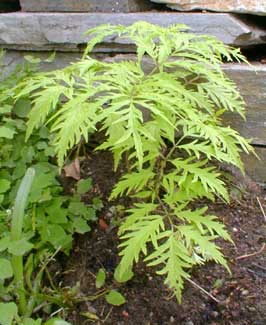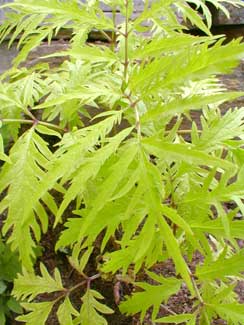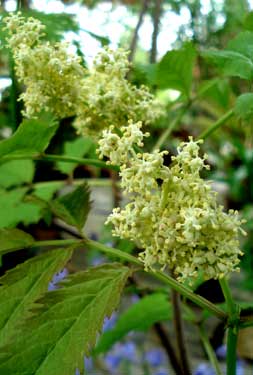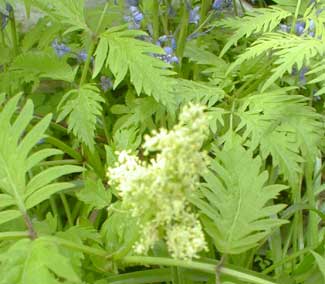
Sutherland Golden
Cutleaf Elderberry
"The elder's bridal in July,
Bright as a cloud!
A ripe blonde girl,
Billowing to the ground in foamy petticoats,
With breasts full-blown
Swelling her bodice."
-Clara Shanafelt
(1888-1957)
(1888-1957)
 Sambucus racemosa 'Sutherland Golden' frequently has its name shortened by two letters to 'Sutherland Gold.' In Spring 2005 we installed a small start of 'Sutherland Golden' on a sloping ledge-shelf separating upper & lower retaining walls
Sambucus racemosa 'Sutherland Golden' frequently has its name shortened by two letters to 'Sutherland Gold.' In Spring 2005 we installed a small start of 'Sutherland Golden' on a sloping ledge-shelf separating upper & lower retaining wallsA year later it had quadrupled in size & begun to look impressive. In another year it was a mid-sized shrub dominating its location, obscuring the stone wall at its back, its yellow foliage hanging far out over a second outer wall below it.
New spring leaves emerge late March golden with coppery highlights & sheen, soon mature to a rich golden yellow, & then very slowly turn lime-green in summer. When several cultivars were evaluated at the University of Michigan horticultural extension, 'Sutherland Golden' scored highest for the longest-sustained & yellowest leaf color.
 The leaves are deeply cut, to the point that it has been described as looking like a gigantic fern.
The leaves are deeply cut, to the point that it has been described as looking like a gigantic fern.An adaptable shrub, swift & vigorous in its growth, 'Sutherland Golden' can tolerate a great deal of sun, & is frequently claimed to be more sun-tolerant than the similar 'Plumusa Aurea.' But all golden varieties of elderberry are inescapably more susceptible to summer leaf-scorch if they entirely unprotected, & will look their best if provided with some shade part of the day, especially in summer afternoons.
Bright shade to deeper shade is preferable in order to retain the best leaf color. It may not bloom & fruit as fully in the deepest shade, so bright shade or dappled shade is the ideal.
 Cold-hardy to zones 3 or 4, the Pacific Northwest (Zone 8) is the "warm" end of its heat-hardiness & it would not be as perfect a shrub if grown inland or further south, but neither is it apt to be as sun-sensitive further north.
Cold-hardy to zones 3 or 4, the Pacific Northwest (Zone 8) is the "warm" end of its heat-hardiness & it would not be as perfect a shrub if grown inland or further south, but neither is it apt to be as sun-sensitive further north.This Award of Garden Merit shrub prefers humus-rich moist well-draining soil, but again, being adaptable, can tolerate a wide range of soil conditions & is drought-hardy when well established, unless in too much sun.
It grows to about eight or twelve feet in height, & up to eight feet wide, but can be a more restrained & compact shrub with regular pruning. It can even be cut back to the ground & will grow back fresh, though if never hard-pruned it will get taller & woodier with its twiggy branches becoming hard warty trunks.
R. racemosa is a "circumboreal" species with many subspecies & variants across its extensive range in the northern hemisphere. The variants & even different species hybridize willfully, giving rise to many cultivated forms.
Late April or May's densely conical racemes of small white flowers are followed by berries that ripen to bright red in summer or autmn. It blooms & fruits later in cooler zones.
The fruits are liked by birds. For human use they are potentially toxic until fully ripened, & even then too bitter to be pleasant raw. But they can be cooked, the poisonous seeds sieved out, & sweetened for a very fine tart jelly.